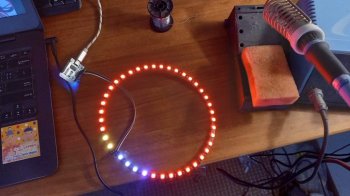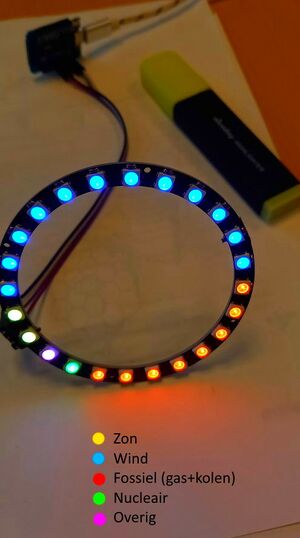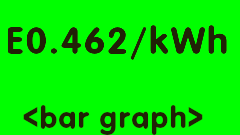PowerLight: Difference between revisions
| Line 133: | Line 133: | ||
* Gerapporteerde wind-opwek vertoont hele grote fluctuaties tot ca 200%, oorzaak onduidelijk, mogelijk incomplete data? | * Gerapporteerde wind-opwek vertoont hele grote fluctuaties tot ca 200%, oorzaak onduidelijk, mogelijk incomplete data? | ||
* Opwek omgerekend naar instantaan vermogen (of KWh / uur) wordt 'capacity' genoemd, merkwaardige naamgeving. | * Opwek omgerekend naar instantaan vermogen (of KWh / uur) wordt 'capacity' genoemd, merkwaardige naamgeving. | ||
Voorlopige conclusie: al-met-al lijkt ned.nl data *niet* betrouwbaar genoeg voor een semi-realtime weergave van opgewekt vermogen! | |||
== Hardware == | == Hardware == | ||
Revision as of 17:22, 16 November 2024
| Project PowerLight | |
|---|---|

| |
| Shows mix of dutch electrical power generation as a pie chart on a LED ring | |
| Status | Completed |
| Contact | bertrik |
| Last Update | 2024-11-16 |
The concept
Show the current dutch electrical power generation-mix as pie chart on a LED ring light, with colors representing fractions of a specific power generation source.
For example:
- yellow: solar
- blue: wind
- red: fossil
- green: nuclear
- purple: other/waste
Power generation data
ENTSO-E data
Information about energy in Europe is collected at the european organisation https://www.entsoe.eu/ . The section about electrical energy is collected in ENTSO-E. Data is available from this platform at a 15-minute interval.
TenneT is the organisation that supplies ENTSO-E with data from the Netherlands.
Information about ENTSO-E generation domain API: https://transparency.entsoe.eu/content/static_content/Static%20content/web%20api/Guide.html#_generation_domain
Also possibly interesting (requires an API key), but might actually just use the entso-e data: https://static.electricitymap.org/api/docs/index.html#introduction
ENTSO-E distinguishes energy generation into several types ("PsrType"). This is how they are relevant to the data from the Netherlands:
- B01 (biomass): always 0, not useful
- B02: not available
- B03: not available
- B04 (fossil hard coal): useful
- B05 (fossil gas): useful
- B06: not available
- B07: not available
- B08: not available
- B09 (geothermal): not available
- B10 (hydro): not available
- B11 (hydro): always 0
- B12 (hydro): not available
- B13 (marine): not available
- B14 (nuclear): useful
- B15 (other renewable): not available
- B16 (solar): hugely underreported, *not* useful
- B17 (waste): useful
- B18 (wind offshore): useful
- B19 (wind onshore): useful
- B20 (other): useful
Additionally, ENTSO-E provides a day-ahead forecast for:
- B16 (solar)
- B18 (wind offshore)
- B19 (wind onshore)
Data schedule
Entso-E provides data with a resolution of 15 minutes. It appears to become available about 5m20s after the start of each 15 minute period (:00, :15, :30, :45). At that point, the most recent data is from an interval that ended 30 minutes ago. So, including the 5m20s minute processing delay, the most recent data available is about 35 minutes old.
The model I use for the energy generation mix of the Netherlands
For me, most insightful information came from this article by Bert Hubert: https://berthub.eu/articles/posts/dutch-electrical-power-figures-2/
Main points relevant for me:
- The solar part reported to entso-e is way too small. Note also at for example https://energy-charts.info/charts/energy_pie/chart.htm?l=en&c=NL that the solar part is tiny
- On-shore wind data is unreliable, but off-shore wind data is probably OK
- No biomass data is reported to entso-e
There is a model that estimates the solar fraction, also at a regional level and at fine time resolution, at https://api.netanders.io/ However use of this model requires a paid subscription, so I cant't use that.
In my backend application, energy generation fractions are calculated as follows:
- solar = B16 (from the time-shifted forecast document A69)
- wind = B18 (offshore, from generation document A75) + B19 (onshore, from time-shifted forecast document A69)
- fossil = B04 (gas) + B05 (coal)
- nuclear = B14
- waste = B17
- other = B20
Solar energy values from the forecast document show a systematic shift of about 30 minutes compared to other sources (e.g. sunrise/sunset data from national weather institute KNMI, energieopwek.nl) so forecast data from the ENTSO-E document is shifted by 30 minutes in my model.
In the end, all of the electrical generation data used in my backend application is ENTSO-E data.
Data model behind CO2monitor.nl
Analysis:
- Much of the data comes from ENTSO-E, except for at least solar, wind, biomass, WKK
- Biomass data seems to follow the coal data exactly in shape. The sum of the biomass and coal numbers at CO2monitor equal exactly the ENTSO-E hard coal number.
- CO2monitor must be assigning some fraction of the ENTSO-E hard-coal number to biomass, it is unknown how they arrive at this fraction
- The biomass fraction seems to be 1295/2740 = 47.3% (data from 18 november 2023)
Some data from CBS on energy use for electricity production in 2022: https://opendata.cbs.nl/statline/#/CBS/nl/dataset/80030NED/table?fromstatweb
- total energy from coal: 53315 TJ
- total energy from biomass: 34798 TJ
This means a ratio of 39.5% biomass vs (biomass + coal), not exactly the CO2monitor number, but on the same order
Nederlands energie dashboard API
Documentatie staat op https://ned.nl/nl/api . Uitleg bronnen bij de definities https://ned.nl/nl/definities
Notes:
- Het content-type is standaard application/json+ld, je ontvangt dan JSON met 'linked data', data is dan gewrapped in een andere structuur. Content-type application/json werkt ook.
- De argumenten zijn case-sensitive, argumenten moeten met kleine letter beginnen. De documentatie toont hoofdletters.
- De volgorde van argumenten is belangrijk, een verkeerde volgorde leidt tot time-outs. Voor de 'juiste' volgorde kan je best de voorbeelden volgen. In ieder geval 'point' of 'validfrom' eerst.
- Het 'utilization' endpoint levert altijd tijdreeksen op. De fijnste resolutie van begin/eind een tijdreeks is een dag. De API heeft geen specifieke mogelijkheid voor opvragen van de meest recente / actuele waarde, je kan de gegevens voor de hele dag opvragen en dan de meest recente waarde gebruiken. Voor verschillende bronnen moet je losse calls maken (let op: rate limit).
Mapping van ned.nl data naar energie-ring:
- solar = 2 (solar)
- wind = 1 (wind) + 51 (offshoreC)
- fossil = 18 (FossilGasPower) + 19 (FossilHardCoal) = zelfde data als ENTSO-E (minus de aanname over de biomassa-fractie?)
- nuclear = 20 (Nuclear) = zelfde data als ENTSO-E?
- waste = 21 (WastePower) = zelfde data als ENTSO-E?
- other = 26 (OtherPower)
Wat nog onduidelijk is / beetje raar:
- Timestamp van data lijkt 'te nieuw', veel van de data komt van entso-e, die loopt al 30-46 minuten achter.
- Bronnen lijken overlap te hebben, hoe voorkom je dat je dingen dubbel telt?
- Bijvoorbeeld biomass, bio-oil, bio-methane, "biomasspower", wood en cofiring, gaat allemaal over biomassa.
- Onderscheid verwarming / elektriciteitsopwek
- Other vs OtherPower, is de eerste inclusief warmte, en de tweede waarschijnlijk alleen elektriciteit
- Er zijn verschillende modellen voor offshore-wind, maar juist de onshore-wind heeft veel onzekerheid
- Hoe werkt het zonne-opwekmodel?
- Bron 'All' is *alleen* hernieuwbare fractie?
- Gerapporteerde wind-opwek vertoont hele grote fluctuaties tot ca 200%, oorzaak onduidelijk, mogelijk incomplete data?
- Opwek omgerekend naar instantaan vermogen (of KWh / uur) wordt 'capacity' genoemd, merkwaardige naamgeving.
Voorlopige conclusie: al-met-al lijkt ned.nl data *niet* betrouwbaar genoeg voor een semi-realtime weergave van opgewekt vermogen!
Hardware
Parts:
- LED ring light, for example
- 24-LED ring https://nl.aliexpress.com/item/32963152993.html I like this one, because it is in one piece and inexpensive
- 40-LED ring https://nl.aliexpress.com/item/1005003798658173.html this has 4 segments that you have to join/solder
- 60-LED ring https://nl.aliexpress.com/item/4000102576864.html also 4 segments
- Wemos D1 mini board + pin headers, containing an ESP8266 microcontroller
- "dupont"-cable, 4 wires
- angled pin header, some rings have 2.0 mm pitch, others have 2.54 mm pitch
- USB-A to USB-micro cable
- 5V USB adapter
Connecting it:
- Solder the straight pin headers that came with it on the wemos d1 mini
- Solder the angled pin to the LED ring
- Connect the dupont cable:
- Wemos 5V goes to 5V on the LED ring
- Wemos GND goes to GND on the LED ring
- Wemos D3 goes to DI on the LED ring
- Wemos D2 goes to DO on the LED ring
This picture stand printed at 40% size works OK for the 24-LED ring.
Diffuser: https://www.thingiverse.com/thing:751894 resize to 89x89x8 mm
Software
The software consists of two parts:
- The backend part that collects the power generation data, written in Java, running on a VPS
- The light part that visualizes the power generation as fractions on a LED ring, running on an Arduino
Backend
Source code: https://github.com/bertrik/energymix-server
Runs as a REST-like resource, with the following endpoints:
- http://stofradar.nl:9001/electricity/generation with details (every 15 minutes) about the current (35-50 minute ago) electricity generation mix, units are MW
- http://stofradar.nl:9001/electricity/capacity with currently (per year) installed generation capacity, by source, units are MW
- http://stofradar.nl:9001/electricity/price with day-ahead hourly electricity price-per-MWh for today, in euro/MWh, multiply by 0.001 to get euro/kWh
- http://stofradar.nl:9001/naturalgas/price with daily natural gas prices (neutral gas price) of TTF spot market, in euro/MWh, multiply by 35.17/3600 (= divide by 102.36 approximately) to get euro/m3
- http://stofradar.nl:9001/naturalgas/flow with daily natural gas flows in/out the dutch natural gas system, units are (MWh/day)
Returns JSON-structures like:
{
"time": 1700728200,
"datetime": "2023-11-23T09:30:00+01:00",
"total": 13552,
"mix": [
{ "id": "solar", "power": 1232, "color": "#FFFF00"},
{ "id": "wind onshore", "power": 4241, "color": "#0000FF" },
{ "id": "wind offshore", "power": 2963, "color": "#0000FF" },
{ "id": "fossil gas", "power": 2264, "color": "#FF0000" },
{ "id": "fossil coal", "power": 2051, "color": "#FF0000" },
{ "id": "nuclear", "power": 483, "color": "#00FF00" },
{ "id": "waste", "power": 70, "color": "#FF00FF" },
{ "id": "other", "power": 248, "color": "#FF00FF" }
]
}
- time is a unix time stamp in seconds, representing the end of the 15-minute period that the power figures refer to
- dateime is ta user-readable time stamp, in dutch local time + offset
- total is the total most recent electrical power (megawatt), suitable for display (on a numeric display inside the ring for example)
- mix is an array of power sources, each with:
- a short unique id
- most recent known power (megawatt)
- hex color, for display on the led ring
{
"current": { "date": "2022-10-30","price": 32.02 },
"day-ahead": [
{ "date": "2022-10-31", "price": 62.631 },
{ "date": "2022-11-01", "price": 49.293 }
]
}
Display
LED ring energy mix

Shows the dutch energy generation mix as a pie chart on a LED ring, one colour per source (solar/wind/fossil/etc) Source code: https://github.com/bertrik/PowerLight
The Arduino sketch polls the REST API using HTTP every minute.
The sketch auto-detects the number of LEDs in the ring, made possible by feeding the digital output of the last LED back into the microcontroller.
WiFi is managed by WifiManager. LEDs are controlled using FastLED. JSON content is parsed using ArduinoJSON.
Hardware that I used:
- Wemos D1 mini, contains an ESP8266 + USB-serial converter
- 24-led pixel ring, for example this one https://nl.aliexpress.com/item/32963152993.html
- "dupont"-cable, you need 4 wires
- wemos 5V to LED ring 5V
- wemos GND to LED ring GND
- wemos D3 to LED ring DI
- wemos D2 to LED ring DO
Firmware installation:
- compiled using platformio
- clone the code from github, enter the PowerLight directory
pio run -t upload
Configuration:
- connect over WiFi to the "ESP-POWERLIGHT" network (no password)
- open page at 192.168.4.1
- enter WiFi credentials (select a network + password)
LED ring price clock
Idea: display relative electricity price on a clock face.
- LED ring with 24 coloured leds, 2 leds per hour
- colour indicates relative price, green = low, red = high
- indicate current time by making the corresponding LED extra bright
Interesting links:
ElectricityPrice
Shows the current dutch electricity price, based on the day-ahead prices from yesterday. Source code: https://github.com/bertrik/ElectricityPrice
The Arduino sketch polls the REST price API using HTTP every 5 minutes. WiFi is managed by WifiManager. JSON content is parsed using ArduinoJSON.
Hardware is an ESP8266 controlling a 7-segment display based on a TM1637, on pins D3 and D4.
T-Display

Alternative: use a TTGO ESP32 T-Display.
It has a 240x135 pixel display. Plan is to show a kind of bar graph with 24 bars (one bar for each hour), each bar's height indicates the price of that hour. The background color shows green/black/red, to indicate cheap/moderate/expensive. Current price is shown as a big number.
Each bar is therefore 10 pixels wide, 9 pixels for the bar + 1 pixel separation.
SHA-badge
The SHA2017 badge has an ESP32 capable of performing the HTTP request, processing the JSON and displaying the result on its display. These badges are limited-edition, a few thousand of them were made for the SHA-2017 event and they're no longer being produced.
It has a 296x128 pixel epaper panel. So that could be a bar graph of 24 bars with a width of 12 pixels each, on the bottom 2/3rds of the display, and a current price on the top 1/3rd of the display.
Could be run as a micropython sketch. Alternatively could be run as an Arduino sketch.
Micropython:
- ++ possibly quick development, script can be shared with other people
- ++ has working libs for fetching HTTP, decoding JSON, controlling the display
- -- script needs frequent garbage collection to avoid crashing?
- -- unclear how to get a python script on this thing
- -- sha badge firmware bootloops, currently unusable to me
Arduino:
- ++ I know this environment, don't have to debug existing bootlooping firmware, no compiler setup required
- ++ Already have HTTP and JSON working on Arduino
- ++ Code starts immediately, no user interaction required
- -- not sure if there is a usable epaper driver